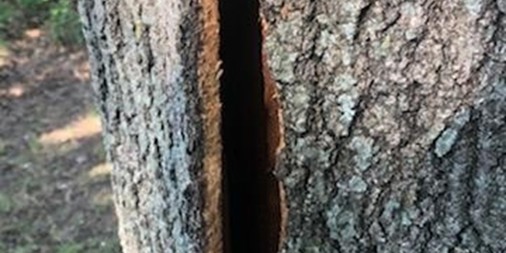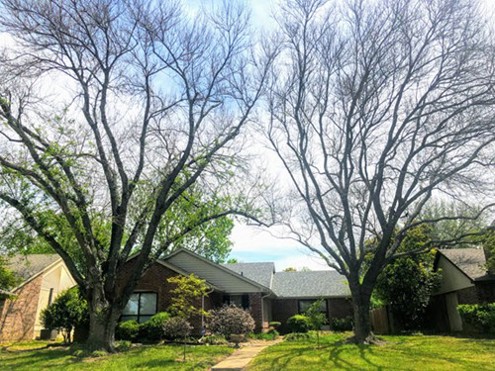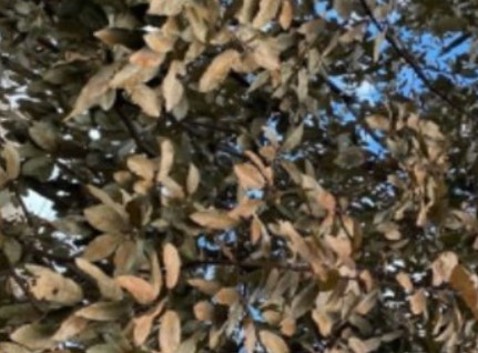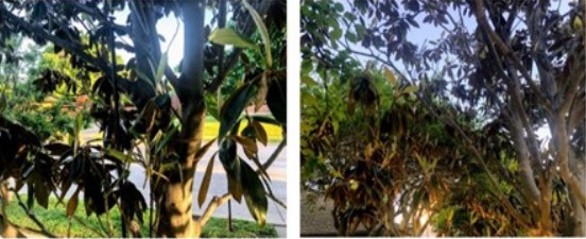Trees Damaged by February's Extreme Cold Weather

(Left) This Red Oak shows the sypstoms of ring shake. Learn more about this cold weather damage in the article.
Published April 29, 2021, By STEVE HOUSER.
Quick Answers to Common Questions
How does extreme cold affect trees? In some cases, plant cells are ruptured as ice crystals are formed. In other cases, expansion and contraction of trunk tissues due to sudden temperature changes can cause cracks and the loss of the vascular system under the bark. The damage is often called frost or freeze cracks, radial shakes or ring shakes. The difference in contraction rates causes the loss or splitting of bark.
The extent of the damage varies by species and the genetics of individual trees. Trees are brought into the Dallas/Fort Worth area from many parts of the country, and some may be more prone to extreme cold damage. More species damage observations are noted below.
What can be done with trees that are not leafing out normally? Unless the tree becomes a hazard to property or person, continue to be patient and wait to evaluate its condition until at least June or July. Healthy trees can use stored energy to rejuvenate leaves.
Remedial treatments aren’t necessary until the tree’s condition is fully evaluated in midsummer. The only exception being the severe loss of bark and vascular system underneath or over 35% of the trunk's diameter. In these cases, an experienced consulting arborist can provide specific recommendations.
By mid to late summer, if a tree has not generated leaves in at least 50% of the canopy, it may not be worth saving. Recommendations from an experienced arborist may be required.
Background
Kevin Bassett and Russell Peters, both plant pathologists and certified consulting arborists with Arborilogical Services have written articles for our company website, Neil Sperry, and industry publications trying to explain to tree owners what to do and what not to do for their trees damaged by the extreme winter temperatures this past February. This unusually cold weather left trees in the Dallas/Fort Worth metroplex with various degrees of damage.
While many appear to be mended or on the mend with near-normal canopies, there are still quite a few trees that have limited foliage of various degrees to no foliage at all. Since some tree species are more tolerant of cold weather, the following is the basic consensus of what the arborists at Arborilogical Services are seeing in the metroplex (in alphabetical order):
- Ash Species: Arizona Ash are severely affected with the majority not leafing out at all. The minority are leafing out very little. So far, our arborists have not seen any significant problems with Green, White, or Texas Ash. Pictured below are two examples of Arizona Ash trees not leafing out, except for new leaves on suckers or interior sprouts.

- Chinese Tallows: Unfortunately, most if not all Chinese Tallow trees appear to be dead.
- Lacebark Elms: Some Lacebark Elm trees appear to have vascular system freeze cracks on the trunk with callus tissue forming underneath. Conditions and the effects on health will vary by individual trees.
- Ligustrums: Most Ligustrums appear dead with a few trying to re-leaf. Those attempting to re-leaf are very “spotty” while others are re-leafing at the base.
- Magnolias: Arborists are reporting some leaf damage on Magnolias, but new leaves seem to be emerging. They may shed quite a bit of old foliage in the next few weeks but they do not appear to be severely affected, at this point.


(Left) This Magnolia is damaged from the February 2021 extreme cold weather event.
(Left) This Magnolia is showing signs of recovery with new leafing.
- Oak Species:
- Blackjack Oaks: Up to five percent may have been affected by the extreme cold temperatures. For those that are, the upper canopy is very slow to leaf out. We are hopeful we’ll see an increase in activity in damaged trees with consistently warmer days and nights.
- Post Oaks: See Blackjack Oak above. Post Oaks are responding in the same way as Blackjack Oaks.

The Post Oak photo on the left was taken April 3rd and the photo on the right is of the same tree taken April 26th. Comparing the two photos, you can tell in the April 26th photo it has new growth, but it appears to be mostly epicormic (or interior) sprouts.
-
- Live Oaks: Between five and ten percent of the Live Oak population appears to be affected with various results. Some Live Oaks are trying to re-leaf on the ends of their branches, while others are growing mostly epicormic or interior sprouts. These Live Oaks still have significant parts of the tree that are not leafing out…yet.
- Red Oaks: Between ten and twenty percent of the Red Oak population appears to be affected with various results. Of that percentage, some appear to be mostly dead (so far) and re-leafing the same as noted above on the Live Oaks. Both the Live and Red Oaks may have vascular system trunk injuries that will become more apparent in the next few months. One client sent photos of trunk damage on a Red Oak that is already apparent.

The Red Oak in the three photos above is showing symptoms of ring shake, a separation of the rings of the wood parallel to the rings and not across the rings. This occurs when pressure builds up inside the tree as it expands and contracts. Eventually, the pressure built up in the tree has to escape and it does so by rupturing the bark.
-
- Sawtooth and Water Oaks: Since the Dallas/Fort Worth area doesn’t have a large number of Sawtooth or Water Oaks, we do not have a projected percentage affected. However, for the very few we have seen, many are not leafing out in the top portion of their canopy.
- Pine Species: The Long Leaf, Slash, Japanese Black, and Afghan are showing dead needles from the previous years' growth but new growth is emerging on the ends. Once the old needles are shed, they will look poor but will at least appear to be alive and recovering.
- Wax Myrtles: Many Wax Myrtles are struggling to survive with a few trying to re-leaf.
- Crepe Myrtle: Around ten to twenty percent of Crepe Myrtles were affected to various degrees.
Other species of trees are either not affected or are not showing effects from the extreme cold, at least not yet. Since we have not experienced this type of extreme cold in many years, the information in this article may need to be updated. It will be a few more months before the full effects of this year’s harsh winter weather will be better understood. The best advice we can offer is not to overreact. Allow trees to respond to the warmer temperatures before determining a course of action. Do not over prune by removing more than 25% of the foliage in any given year and never “top” any tree, including a Crepe Myrtle.

